Discover 20 hidden attractions, cool sights, and unusual things to do in North Macedonia. Don't miss out on these must-see attractions: Church of Saints Clement and Panteleimon (Ohrid), Church of St. John at Kaneo (Ohrid) or Matka Canyon (Skopje).
Below, you can find the list of the most amazing places you should visit in North Macedonia.
Table of Contents
Church of Saints Clement and Panteleimon, Ohrid

Also known as: Црква „Св. Климент и Пантелејмон“ - Охрид
Orthodox church in Ohrid, North Macedonia. The Church of Saints Clement and Panteleimon is a Byzantine church situated on Plaošnik in Ohrid, North Macedonia. It is attributed to Saint Clement of Ohrid, a disciple of Saint Cyril and Saint Methodius. Archaeologists have come to believe that the church is located on the site where the first students of the Glagolitic alphabet were taught into the First Bulgarian Empire.[1]
Church of St. John at Kaneo, Ohrid
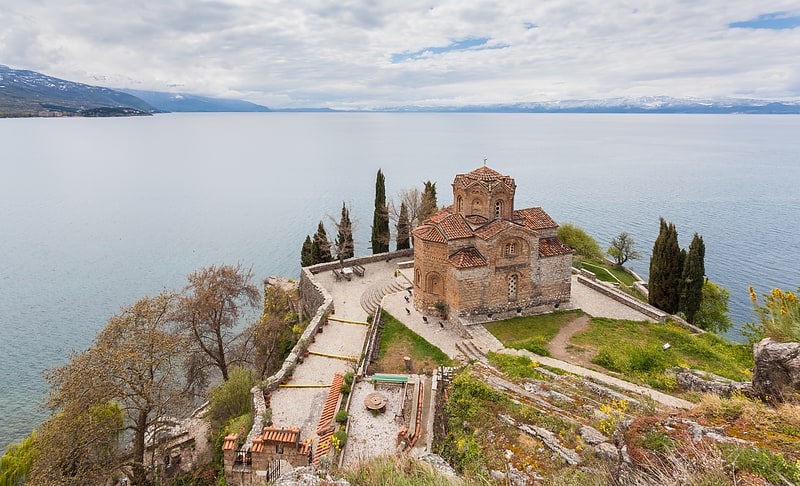
Also known as: Црква „Св. Јован Канео“ - Охрид
Grand historic church with lake views. Saint John the Theologian, Kaneo or simply Saint John at Kaneo is a Macedonian Orthodox church situated on the cliff over Kaneo Beach overlooking Lake Ohrid in the city of Ohrid, North Macedonia. The church is dedicated to John of Patmos, the writer of Revelation, who has been by some considered to be the same person as John the Apostle. The construction date of the church remains unknown but documents detailing the church property suggest that it was built before the year 1447. Archaeologists believe that the church was constructed some time before the rise of the Ottoman Empire very likely in the 13th century. Restoration work in 1964 led to the discovery of frescoes in its dome.[2]
Address: Kaneo Plaosnik Pateka, 6000 Ohrid
Matka Canyon, Skopje
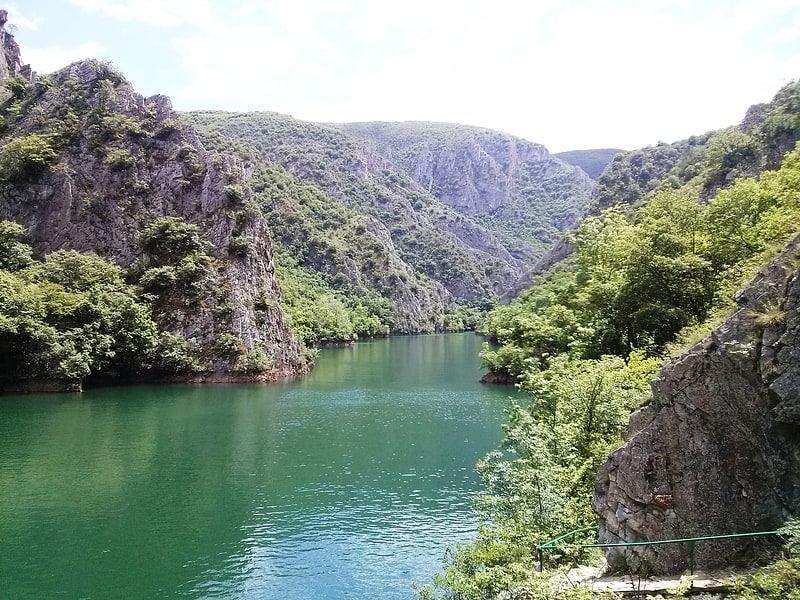
Also known as: Матка
Lakeside hotel with a wine cellar. Matka is a canyon located west of central Skopje, North Macedonia. Covering roughly 5,000 hectares, Matka is one of the most popular outdoor destinations in North Macedonia and is home to several medieval monasteries. The Matka Lake within the Matka Canyon is the oldest artificial lake in the country.[3]
Old Bazaar, Skopje

Also known as: Стара скопска чаршија
Old bazaar dating from the 12th-century. The Old Bazaar is a bazaar located in Skopje, North Macedonia, situated on the eastern bank of the Vardar River, stretching from the Stone Bridge to the Bit-Pazar and from the Skopje Fortress to the Serava river. The Old Bazaar falls primarily within the borders of Čair Municipality but a part of it is located in Centar Municipality. As one of the oldest and largest marketplaces in the Balkans, it has been Skopje's centre for trade and commerce since at least the 12th century.
The earliest known sources that describe the existence of a merchant quarter on the bazaar's territory date back to the 12th century. During Ottoman rule of Skopje, the Old Bazaar developed rapidly to become city's main centre of commerce. The Ottoman history of the bazaar is evidenced by roughly thirty mosques, numerous caravanserais and hans, among other buildings and monuments. The bazaar was heavily damaged by the earthquake in 1555, the burning of the city in 1689, the earthquake in 1963, as well as during the First and the Second World Wars and faced various rebuildings following these events.
Beside its importance as a market place, the Old Bazaar is known for its cultural and historical values. Although Ottoman architecture is predominant, remains of Byzantine architecture are evident as well, while recent reconstructions have led to the application of elements specific to modern architecture. The Old Bazaar is still home to several active mosques, türbes, two churches and a clocktower, that, together with the buildings of the Museum of the Republic of North Macedonia and the Museum of Modern Art, form the core of the modern bazaar.
In recent years there have been a raising interest to make the Bazaar a touristic attraction. On 13 October 2008, the Macedonian Parliament adopted a law recognising the Old Bazaar as cultural heritage of particular importance for the country to be permanently protected. In early 2010, the Macedonian Government began a project for the revitalisation of the Old Bazaar, which includes the restoration of several objects and aiming a further economic and cultural development of the site.[4]
Skopje Fortress, Skopje
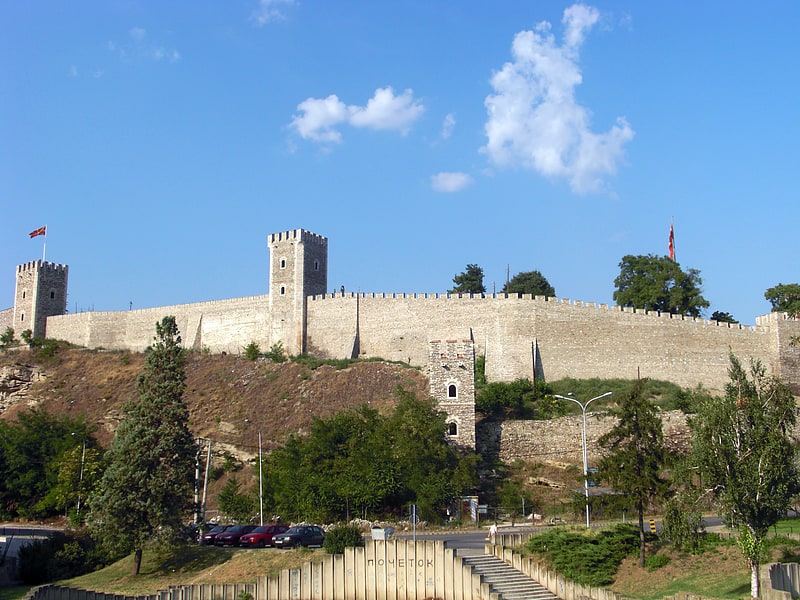
Also known as: Скопско кале
6th-century fortress with sweeping views. The Skopje Fortress, commonly referred to as Kale, is a historic fortress located in the old town of Skopje, the capital of North Macedonia. It is located in Centar municipality and situated on the highest point in the city overlooking the Vardar River. The fortress is depicted on the coat of arms of Skopje, which in turn is incorporated in the city's flag.[5]
Samuel's Fortress, Ohrid
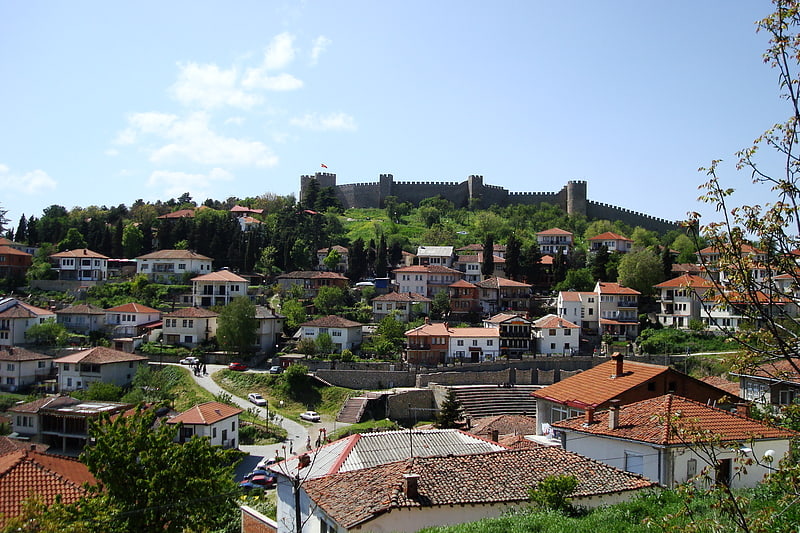
Also known as: Самуилова тврдина
Imposing Byzantine era city wall ruins. Samuel's Fortress is a fortress in the old town of Ohrid, North Macedonia. It was the capital of the First Bulgarian Empire during the rule of Tsar Samuel of Bulgaria at the turn of the 11th century. Today, this historical monument is a major tourist attraction and was heavily restored in 2003 with the addition of entirely new battlements where none had survived.
According to recent excavations by Macedonian archaeologists, it was contended that this fortress was built on the place of an earlier fortification, dated to the 4th century BC, which was probably built by King Philip II of Macedon. During the late 900s, King Samuil of Bulgaria restored the fortress by rebuilding it into a medieval style stronghold which still stands as is today.[6]
Address: Braka Miladinovtsi st, Ohrid
Šarena Džamija, Tetovo
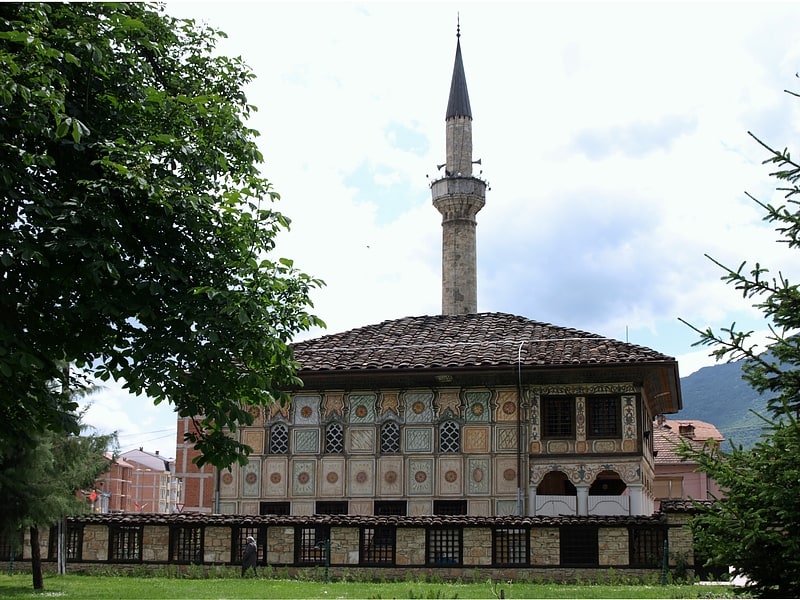
Also known as: Шарена џамија
Mosque in Tetovo, Macedonia (FYROM). Šarena Džamija, meaning Decorated Mosque in English but also variably translated as Painted Mosque, is a mosque located near the Pena River in Tetovo, North Macedonia. The mosque was originally built in 1438 and later rebuilt in 1833 by Abdurrahman Pasha. Unlike other mosques of the Classical Ottoman period, the Šarena Mosque is more characteristic of traditional mosques in Anatolia, as it was constructed before the conquest of Constantinople, when Byzantine-influenced mosque domes became the standard design.[7]
Address: Браќа Миладинови, Tetovo
Saint Jovan Bigorski Monastery, Mavrovo National Park
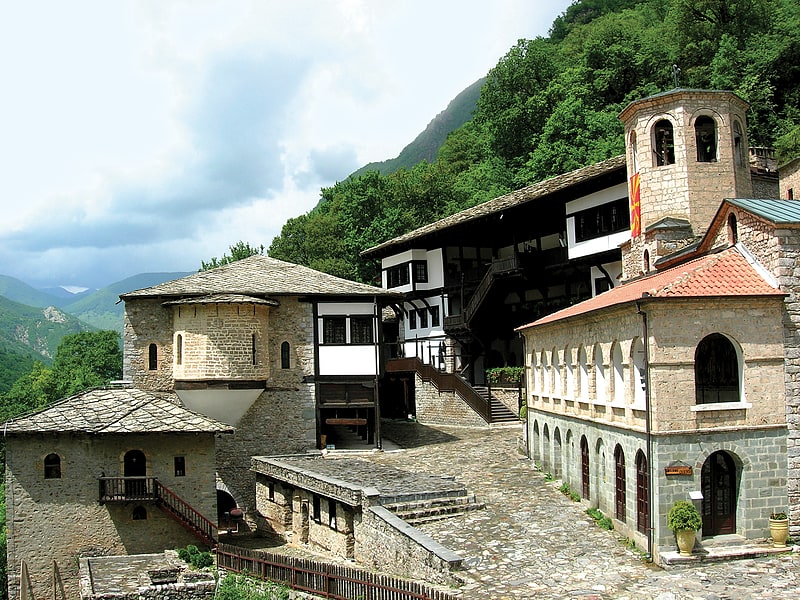
Also known as: Бигорски манастир
Monastery in the Republic of Macedonia. The Monastery of Saint Jovan Bigorski is a Macedonian Orthodox monastery located in the western part of North Macedonia, near the road connecting the towns of Debar and Gostivar.
The monastery church is dedicated to St. John the Baptist. One of its most valuable treasures is the iconostasis, created by Petre Filipovski - Garkata from the nearby village of Gari, and considered one of the finest examples of wood-carved iconostases.[8]
Address: Hwy E65 Mavrovo National Park, Mavrovo National Park
Bitola Zoo, Bitola

Also known as: Зоолошка градина Битола
Zoo in the Republic of Macedonia. The Bitola Zoo, is a zoo in Bitola, North Macedonia. It was founded on 1 May 1950 with the help of zoos in Skopje, Zagreb, Belgrade and Subotica.
The Bitola zoo plays a significant role in the sphere of social living, especially in the sector of education as well as the protection of certain animal species. Ever since its establishment as an institution in 1950, the zoo has been constantly improving the conditions in order to meet European standards, but these standards have not yet been met. In 2004, a number of activities have started, aimed at improving the conditions in which the animals live and raising the educational character of the zoo.[9]
Heraclea Lyncestis, Bitola

Also known as: Хераклеја Линкестис
City in the Republic of Macedonia. Heraclea Lyncestis, also spelled Herakleia Lynkestis, was an ancient Greek city in Macedon, ruled later by the Romans. Its ruins are situated 2 km south of the present-day town of Bitola, North Macedonia. In the early Christian period, Heraclea was an important Episcopal seat and a waypoint on the Via Egnatia that once linked Byzantium with Rome through the Adriatic seaport Dyrrachium. Some of its bishops are mentioned in synods in Serdica and other nearby towns. The city was gradually abandoned in the 6th century AD following an earthquake and Slavic invasions.[10]
Address: 41. 011036, 21. 342487, 1000 Bitola
Clock Tower, Bitola
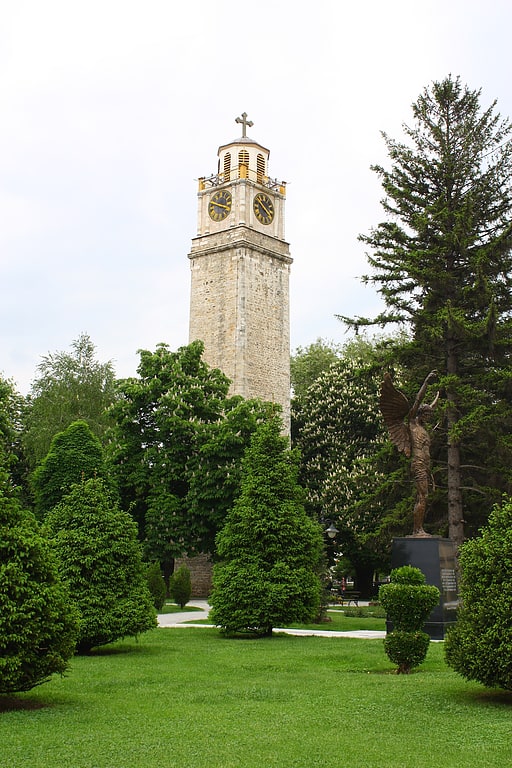
Also known as: Саат-кула
Tourist attraction in Bitola, North Macedonia. The Clock Tower of Bitola, known as Saat Kula, is a clock tower and one of the landmarks of the Macedonian city of Bitola. The clock tower in Bitola is a very practical monument aiding people with the time of day.
The original clock tower was first built in 1664 by Mahmut Bey when the city was part of the Ottoman Empire and known as Manastır. Legend has it that the Turks collected 60,000 eggs from the surrounding villages and mixed the shells into the construction mortar. The Ottomans rebuilt the tower in the 1830s, in the same period when the Orthodox Church of St. Demetrius was being built.
It is located in the immediate center of Bitola on the northern part of the main street Širok Sokak not far away from Magnolia Square, where there are numerous cultural and historical monuments, as well as new construction. The clock tower is 33 meters high, with sides of per 5.8 m. On all four sides are entrenched special metal plates mounted to the hands and inscribed with Roman numbers from one to twelve. During the Turkish era, the numbers used were Eastern Arabic numerals. On the uppermost part is a small dome, which offers a beautiful panorama of the city and the wider environment. In more recent times restoration was conducted on the tower, which has not changed its original appearance.
The clock tower was constructed with massive stone blocks. The main and also most decorative part of the clock tower is the part where you set the clock. The entrance to the clock tower encircled by large marble blocks is located on the north side and about a hundred stairs leads to the clock, to its peak of approximately 32 m. These steps lead to the top where in the past the big metal bells stood indicating the time. In 1927 its first clock mechanism was developed by the German company Konfage. People that were required to ring the bells were replaced with so called sajdzhii (clock keepers) who were responsible for maintaining the clock and the clock mechanism. At first there was white clock face with black numbers and hands, and was smaller than the present. This clock mechanism was replaced in 1936. 15 new bells (weighing 900 kg) were placed in the tower as a sign of gratitude for the construction of the Memorial Cemetery of German soldiers killed in the First World War.
In 1962 the mechanism was restored, and in 1970 a keyboard mechanism was installed to play new songs. The clock tower is one of the 180 towers in the world which has embedded such a mechanism.
In 2015, an old Turkish inscription dedicated to the tower, long thought lost, was rediscovered and reassembled at the nearby Gazi Hajdar Kadi Mosque. It was crafted by the renowned Ottoman calligrapher Kazasker Mustafa Izzet Efendi, whose work includes the giant medallions on the cornices of the Hagia Sophia in Istanbul.[11]
Address: 11 Октомври, Bitola
Mavrovo Lake, Mavrovo National Park
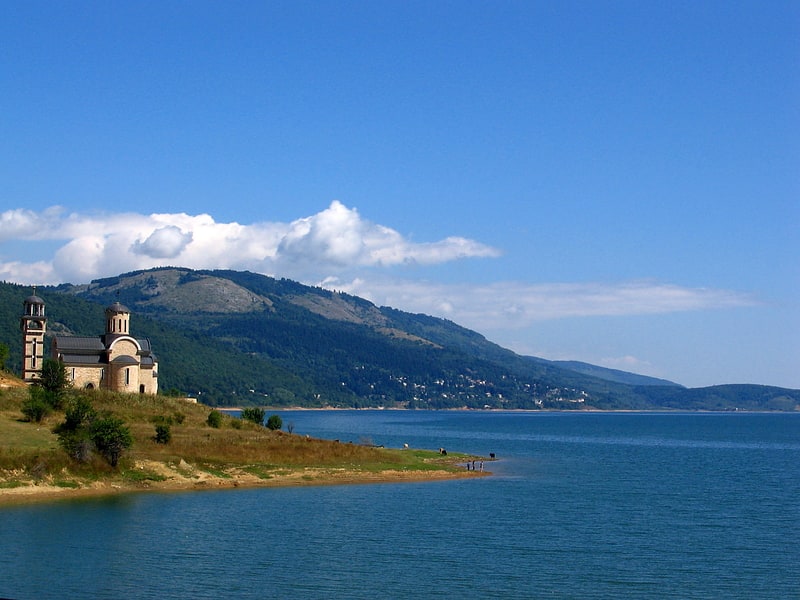
Also known as: Мавровско Езеро
Lake in the Republic of Macedonia. Mavrovo Lake is situated in the Mavrovo region, in the Mavrovo and Rostuša municipality of the Republic of North Macedonia, less than 100 km from Skopje. It is an important tourist destination, being frequented for recreational activities such as swimming, boating and trout fishing during the summer; a distinctive building in the lake is the half-submerged church of Saint Nicholas. Since 1952 it is part of the Mavrovo National Park. With its surface of 13.7 km2, is one of the most extensive artificial lakes of the country.
The lake is surrounded by the Šar Mountains on the North and the Bistra Mountains on the South, both exceeding heights of 2000 m.[12]
Korab-Koritnik Nature Park, Mavrovo National Park
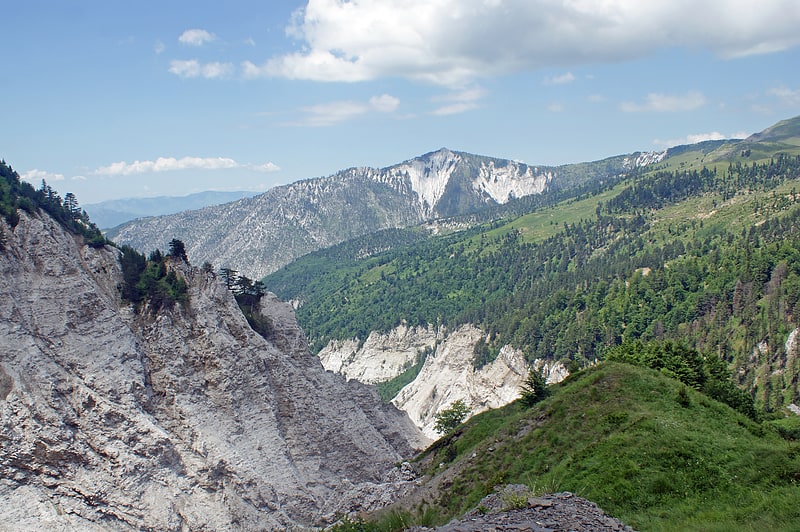
Park in Albania. The Korab-Koritnik Nature Park is a nature park in eastern Albania and forms a section of the European Green Belt, which serves as a retreat for endangered animal and plant species. It encompasses 55,550 hectares of alpine mountainous terrain, with valleys, rivers, glacial lakes, caves, canyons, dense coniferous and deciduous forest. The International Union for Conservation of Nature has listed the park as Category IV. Both, Koritnik and Korab has been recognised as an Important Plant Area of international importance by Plantlife.
Korab-Koritnik Nature Park starts on the frontier with Kosovo in the north along the border with North Macedonia to the Desha Mountains in the south. The nature park is named after the Korab Mountains and Koritnik Mountain. Korab is the highest summit of both Albania and North Macedonia, standing at an elevation of 2,764 metres (9,068 ft). It is also one of only two summits in Europe, which is the highest point for more than one country and as well the 18th-most prominent mountain peak in Europe. The summit is a very rugged mountain massif and consists mainly of shale and limestone of the Paleozoic period with block structures and also severely damaged gypsum rocks of permo Triassic. On the west side, the mountain falls steeply over rock walls, while the north side consists of craggy rocks.
The nature park experiences a moderate humid continental climate with wet cold winters and dry hot summers. Due to a great variability in elevation, a rich diversity of climates, flora and fauna can be found within the territory. It falls within the Dinaric Mountains mixed forests and Balkan mixed forests terrestrial ecoregions of the Palearctic temperate broadleaf and mixed forests biome. The forests are composed by diverse species of deciduous and coniferous trees and a great variety of wildflowers. The levels of the vegetation are distinguished based on different altitudes, oak forests from 400 to 900 metres (1,300–3,000 ft), conifers and beech forests with mixed broadleaved forests from 1,000 to 2,000 metres (3,300–6,600 ft) above sea level. The slopes of the mountain meadows are mostly covered with deciduous forests. The most common types of tree in the park are silver fir, austrian pine, bosnian pine, macedonian pine and black alder. Oak forests can be found on the lower altitudes including the oriental hornbeam, downy oak, macedonian oak and field maple.
The fauna is represented by 37 species of mammals. Large mammals such as the brown bear, grey wolf, balkan lynx, roe deer, wild boar, weasel, pine marten, and red squirrel can be found in the area. It also contains a variety of suitable habitats that support dense populations of birds such as the golden eagle, western capercaillie, peregrine falcon, common buzzard, accipiter, eagle-owl, griffon vulture, hazel grouse and many other.[13]
Arabati Baba Teḱe, Tetovo
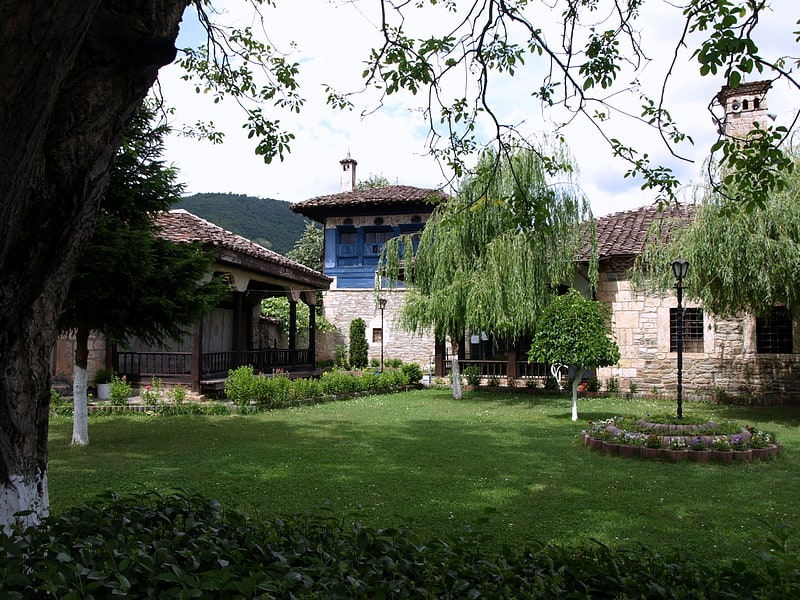
Also known as: Арабати баба-теќе
Monastery in Tetovo, Macedonia (FYROM). The Arabati Baba Tekḱe is a tekḱe located in Tetovo, North Macedonia. The tekke was originally built in 1538 around the türbe of Sersem Ali Baba, an Ottoman dervish. In 1799, a waqf provided by Recep Paşa established the current grounds of the tekke. The finest surviving Bektashi lodge in Europe, the sprawling complex features flowered lawns, prayer rooms, dining halls, lodgings and a great marble fountain inside a wooden pavilion.
Due to its striking architecture, the Arabati Baba Tekke has become an iconic symbol of Tetovo, and is featured on its municipal coat of arms.[14]
Brvenica, Tetovo

Brvenica is a village in the municipality of Brvenica, North Macedonia. It is the seat of the Brvenica Municipality.[15]
Treskavec Monastery, Prilep
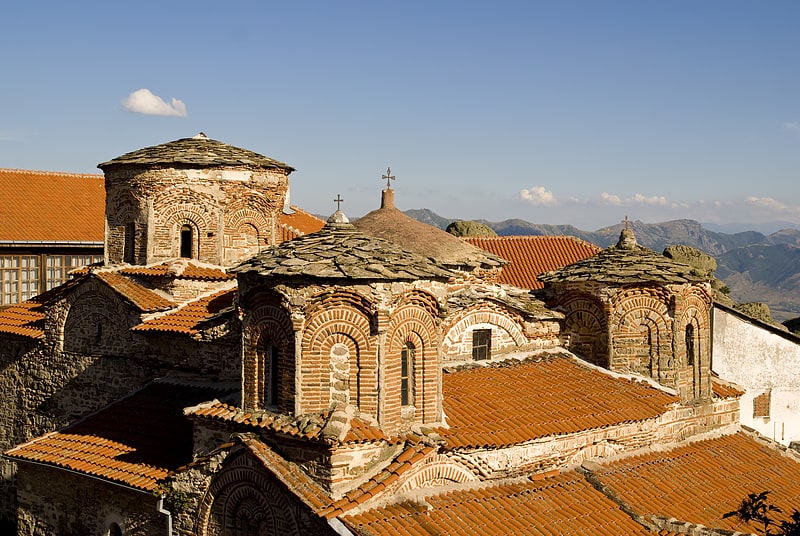
Also known as: Трескавец
Monastery in the Republic of Macedonia. The Monastery of Treskavec, or St. Bogorodica, is a monastery situated on the rocky Mount Zlatovrv, 8 km north of Prilep, in North Macedonia. Built in the 12th century, it currently has only one monk.
The monastery possesses a large collection of Byzantine frescoes. The oldest remaining date from the 15th century.
It was rebuilt in the 14th century by Serbian kings Stefan Milutin and Stefan Dušan. In the mid-16th century it was renovated by knez Dimitrije Pepić of Kratovo.
The monastery was largely destroyed by a fire in the early 2010s, although the church remaimed untouched. The rebuilding of the monastery is in the last phase, and it is expected for the monastery to open at this year's Orthodox Easter.
The monastery was the burial place of Serbian noblemen Dabiživ Čihorić and Gradislav Borilović.[16]
Markovi Kuli, Prilep
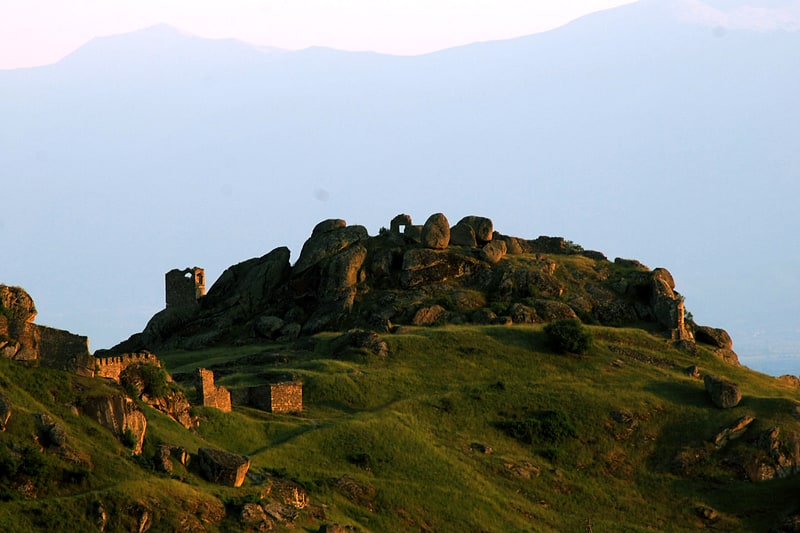
Also known as: Маркови Кули
Historical landmark in the Republic of Macedonia. Markovi Kuli or Marko's Towers are situated to the northwest of Prilep, North Macedonia, just above the village of Varoš. The towers, named after Serbian medieval Prince Marko Mrnjavčević, are located on a 120–180 m high hill, surrounded by steep slopes covered with minute granite stones. The upper part of the former settlement can be reached from its north and south side.
During the four-decade archaeological research, remnants indicating the existence of an early antique settlement — Keramija, were found. In the Roman period, this small village expanded into the southwest, a fact suggested by the several marble ornaments of an early Christian basilica.
The rampart on this terrain dates from the 13th and 14th centuries and is in good condition. The walls are about one meter thick and were built of limestone mortar and rest upon the large limestone rocks.
Internal walls separated the acropolis into smaller areas. The palace of Serbian King Vukašin and his son Marko was also situated here. Its north gate has a compound foundation - an evidence for of numerous reconstructions of the space. According to some historical findings, until the second part of the 14th century and even later, this fortress was defended by only 40 soldiers.
The settlement was situated south of the acropolis on a surface of some 3,6 hectares. On its north side, there is a double gate, as well as a large guardhouse between the entrances. On the south wall there are three well-preserved towers.
The lowest zone of the rampart consists of a row of short walls drawn in a broken line. In the west side, there are graves inserted into the rock. In the 14th century, this part served as a temporary refuge of the local population from Turkish raids.
After the death of King Marko in 1395, this settlement was taken by Ottoman forces. At this time the inhabitants of the former settlement migrated to a new settlement at the foot of Marko's towers. It was separated into several quarters and each had its own church. This new settlement from the 14th century was given the name Varoš which is still in use today.[17]
Church of the Holy Trinity, Kumanovo

Also known as: Црква „Св. Троица“ - Куманово
Church in Kumanovo, Macedonia (FYROM). The Church Holy Trinity, Kumanovo is an Orthodox church in the city of Kumanovo, North Macedonia.
Since they were not admitted to the Church of St Nicholas, controlled by the Bulgarian Exarchate, the local Serbs decided to build a church of their own. They called for help from the Serbian government who sponsored the drawing of its blueprints, done by Russian architect Vladimir Antonov. The church was built during 1901 by Mihajlo Djordjević from Debar. The iconostas was made from a donation by Queen Draga of Serbia and featured many Serbian saints such as St Sava, Prince Lazar and St Uroš.[18]
Memorial Ossuary Kumanovo, Kumanovo
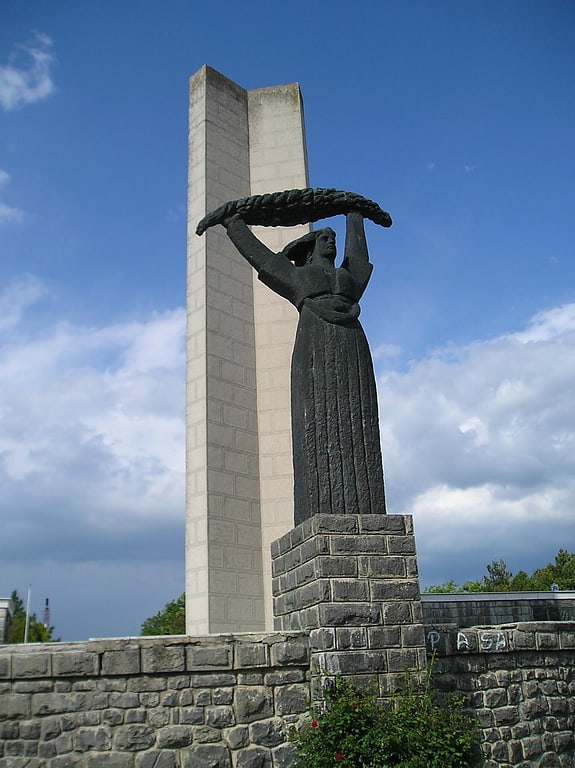
Memorial Ossuary Kumanovo is a memorial monument located in Kumanovo, North Macedonia. Itconsists of an obelisk and an ossuary containing the remains of communist guerrillas, killed during WWII in Kumanovo area.[19]
Matejče Monastery, Kumanovo
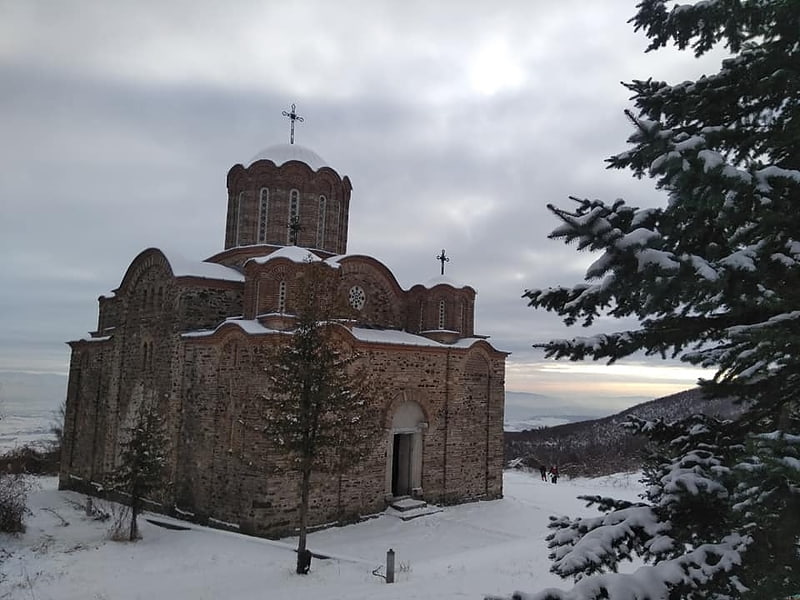
The Monastery of the Most Holy Mother of God, commonly known as Matejče or Matejić, is a 14th-century Orthodox monastery located in the village of Matejče on the slopes of Skopska Crna Gora, near Skopje and Kumanovo. The village is inhabited by 89% Muslim Albanians and 10% Orthodox Serbs.
The monastery was built in the 14th century on the ruins of an older, Byzantine Greek church built in 1057–59, as evidenced by preserved Greek inscriptions. It was mentioned for the first time in 1300 in a chrysobull of the Serbian king Stefan Milutin (r. 1282–1321). In the mid-14th century, the Serbian emperor Stefan Dušan (r. 1331–55) started reconstructing the monastery, finished by his son Stefan Uroš V in 1357 (thus becoming his endowment). Coins of Uros V has been found at the site. Isaiah the Serb and Vladislav Gramatik lived in the monastery. In the 18th century the roof was removed by the Ottomans and put on the Eski Mosque in Kumanovo, after which it deteriorated. In 1926–34 the monastery was renovated.
It is designed in the cross-in-square plan (as is also Marko's Monastery and the Banja Monastery). The dome bears the same exonarthex technique as Hilandar. It was painted in 1356–57.
The monastery was occupied and desecrated by Albanian insurgents and used as a base and munition storage during the Insurgency in the Republic of Macedonia (2001). Serbian Patriarch Pavle issued a statement to the UN regarding the destruction of Serbian monasteries in Kosovo, and the threat of destruction of monasteries in Macedonia. The church exterior was not damaged, however, the interior and inventory were stolen or burnt.
During the conflict, the surrounding area saw the forced expulsion of ethnic Serbian and Macedonian inhabitants, whose houses were set to fire, and who never managed to return to their homes.[20]
Address: village of Matejče, Kumanovo